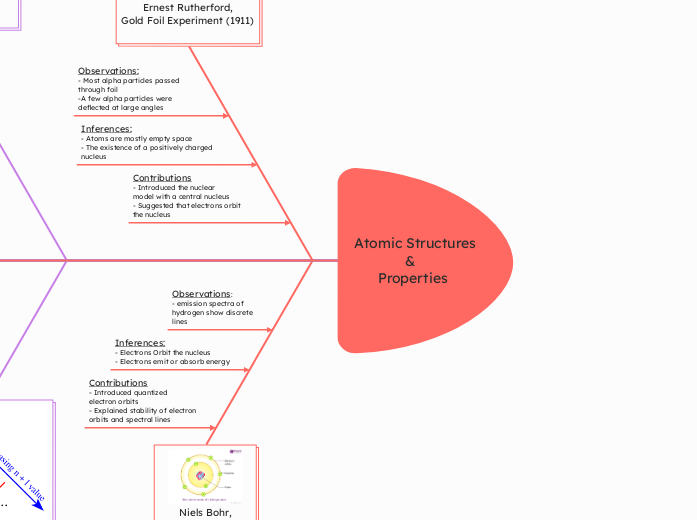Atomic Structures
&
Properties
Ernest Rutherford,
Gold Foil Experiment (1911)
Observations:
- Most alpha particles passed
through foil
-A few alpha particles were
deflected at large angles
Inferences:
- Atoms are mostly empty space
- The existence of a positively charged
nucleus
Contributions
- Introduced the nuclear
model with a central nucleus
- Suggested that electrons orbit
the nucleus
Hunds Rule
Bent
Electron Groups: 3
Bonded Atoms: 2
Lone Pairs: 1
Bond Angles: <120°
Example: SO2
Trigonal Planar
Electron Groups: 3
Bonded Atoms: 3
Lone Pairs: 0
Bond Angles: 120°
Example: BF3
Trigonal Pyramidal
Electron Groups: 4
Bonded Atoms: 3
Lone Pairs: 1
Bond Angles: <109.5°
Example: NH3
T-Shaped
Electron Groups: 5
Bonded Atoms: 3
Lone Pairs: 2
Bond Angles: <90°
Example: ClF3
Square Planar
Electron Groups: 6
Bonded Atoms: 4
Lone Pairs: 2
Bond Angles: 90°
Example: XeF4
Polarity
The physical properties of solids and liquids depend on intermolecular forces (dispersion, dipole-dipole, hydrogen bonding, ion-dipole) and intramolecular forces (covalent, ionic, metallic). Stronger forces lead to higher melting and boiling points. Covalent network solids are very hard, ionic compounds are hard and brittle, and metals are malleable and conductive. Solubility follows "like dissolves like."
Niels Bohr,
Bohr Model
of The Atom (1913)
Observations:
- emission spectra of
hydrogen show discrete
lines
Inferences:
- Electrons Orbit the nucleus
- Electrons emit or absorb energy
Contributions
- Introduced quantized
electron orbits
- Explained stability of electron
orbits and spectral lines
Aufbau Principle
Linear
Electron Groups: 2
Bonded Atoms: 2
Lone Pairs: 0
Bond Angles: 180°
Example: CO2
Tetrahedral
Electron Groups: 4
Bonded Atoms: 4
Lone Pairs: 0
Bond Angles: 109.5°
Example: CH4
Trigonal Bipyramidal
Electron Groups: 5
Bonded Atoms: 5
Lone Pairs: 0
Bond Angles: 90°, 120°
Example: PCl5
Octahedral
Electron Groups: 6
Bonded Atoms: 6
Lone Pairs: 0
Bond Angles: 90°
Example: SF6
Seesaw
Electron Groups: 5
Bonded Atoms: 4
Lone Pairs: 1
Bond Angles: <90°, <120°
Example: SF4
Square Pyramidal
Electron Groups: 6
Bonded Atoms: 5
Lone Pairs: 1
Bond Angles: <90°
Example: BrF5
